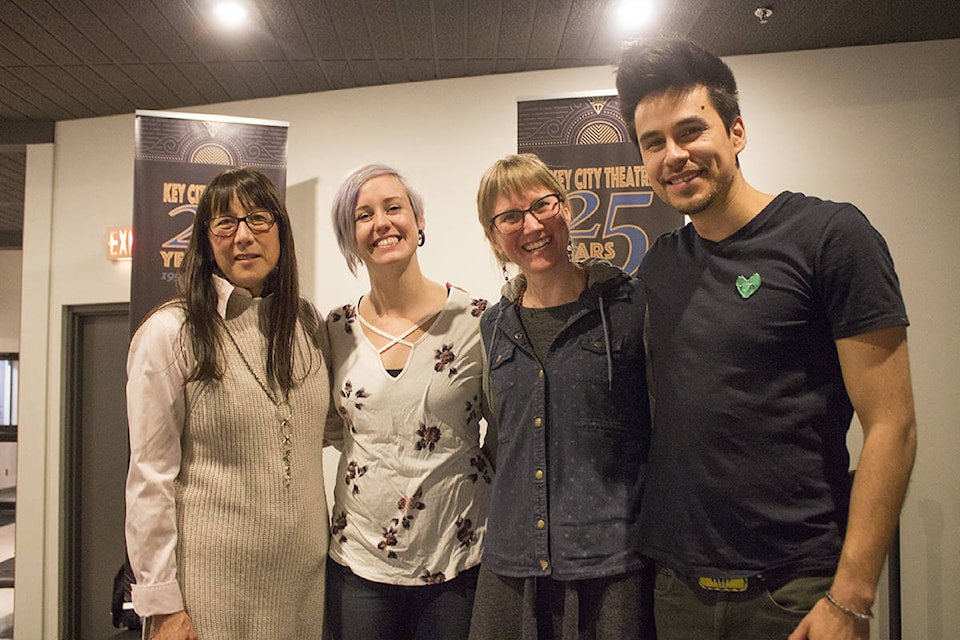Harm reduction teams from around the East Kootenay have combined their efforts and collected material to create an art show called The Compassion Project that exists to spark curiosity about the values, beliefs and assumptions that surround drug use, with the ultimate goal of building compassion through increased awareness and understanding.
WATCH:
The show consists of a collection of stories, information and photographs from those impacted by or working with the opioid crisis. Community members who volunteer to participate int he project were asked to contribute a meaningful photo and were asked two questions: “how do you want to be understood?” and “what is it like to be you?”
So far there have been four events beginning in Fernie on March 6 and then in Invermere, Golden and Cranbrook — which took place on Friday, March 9 at Key City Theatre. Events are in the works for Kimberley and Creston.
The spring events are led by Warren Hooley, an aboriginal facilitator and practising artist who is a member of the IndigenEYEZ leadership team. Hooley guides participants through a series of activities with the intention of experiencing a sense of connection.
Jen Driscoll, a registered psychiatric nurse with the Harm Reduction Team of East Kootenay Addictions Services Society (EKASS) and Allison Ko, registered nurse, and health outreach nurse with Interior Health Authority sat down with the Townsman at the EKASS office on the Monday following the event.
They explained that the idea for the project came from the Canadian Institute for Substance Use Research (CISUR), who put out a call in April 2017 for communities to support dialogues around opioid use.
“So we applied as representing the East Kootenays as a collaborative group that has been working together, as a collaborative harm reduction group, because we both hold regional positions we were able to do that,” Driscoll said. They prepared the grant and were successful in receiving funds and began working to establish harm reduction teams throughout the East Kootenays, then pitched the idea to them.
The other teams were open to the idea and they decided as a group that they would use photo voice as their means to dialogue.
“[CISUR was] very clear that dialoguing meant specific things,” explained Driscoll. “So it wasn’t about didactic conversation, it wasn’t about debating, it wasn’t about finding solution or coming up with a way to fix the opioid crisis.”
Their plan was to create safe spaces to allow “silent voices” — people who are disconnected from the system — to come forward and share their stories, because they believe that these individuals hold important knowledge.
They also needed to include the voices of the RCMP and First Nations. Ko explained that initially the funds, which came from the attorney general, were meant to go towards policing and enforcement.
“And so it was quite a leap to say, maybe we shouldn’t do that, maybe we need to understand this problem before we come up with solutions, so we needed RCMP representation, First Nations people who have experience with opioids and the silent voices and health care.”
Not only is it a challenge to get those silent voices of drug users and people who have first-hand experience with the opioid crisis to share their stories, it was also challenging to determine the best way to present the project, because it deals with very polarizing subject matter and because individual people take in information differently.
“So we kind of had a hunch that that some people can read [the photo voices] and maybe not share and some people might want to share what they thought and how they felt and how they want to act,” said Ko.
“But we wanted some way to measure that,” added Driscoll. “So part of it was we wanted people to just connect on a real human level and not see each other for being a nurse, or being someone who uses drugs or an RCMP officer, just as people coming together as a community to connect.”
The activities that Hooley conducted encouraged this connection between the participants. For example, he had people mingle about the crowd and partner up with a stranger, make eye contact, interact with each other, and share stories. After that they went up the stairs to the second level of Key City to connect with the photo voices.
“So it wasn’t didactic, they were just able to read the photo voice, the narrative piece, look at the photo, and the hope is that they’d start to have a felt sense of connection or understanding.”
Part of the intent of the project is to identify the unique needs of each different community in terms of harm reduction and addiction — there were participants from places like Jaffray and Fairmont as well as the larger centres.
“The other piece that the [CISUR] was clear about was we need to hear from a wide range of voices so that we can find solutions for many different people in communities and not one certain group,” said Driscoll. “And you couldn’t move to action, you can’t look for solutions, until you actually understand what the problem is.”
The true impact of Friday’s event is still being processed, both Ko and Driscoll agreed, but they did have some initial impressions.
“Personally, and again I haven’t had a tonne of time to reflect, but really how easily the community did come together and interact with each other,” said Driscoll.
“The one thing that just came up immediately on Friday was how empowering and how proud people who came to show those stories were up there,” said Ko. “How proud they were to be up there and that included health care providers and people who have experience with opiates.”
The Townsman will continue to follow this project as it develops.
